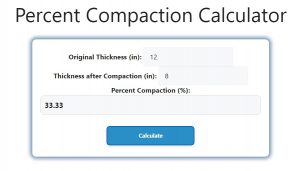About Percent Compaction Calculator (Formula)
The Percent Compaction Calculator is a valuable tool for civil engineers, construction professionals, and geotechnical engineers who need to determine the effectiveness of compaction in construction projects. Compaction is essential for ensuring the stability and durability of foundations, roads, and other structures. By calculating the percent compaction, you can assess how well the soil or material has been compacted, which is crucial for achieving the desired structural integrity and performance.
Formula
The formula for calculating Percent Compaction is:
Percent Compaction (PC) = ((Original Thickness – Thickness after Compaction) / Original Thickness) * 100
Where:
- PC is the percent compaction.
- Original Thickness refers to the thickness of the material before compaction.
- Thickness after Compaction is the thickness of the material after it has been compacted.
How to Use
To use the Percent Compaction Calculator, follow these steps:
- Measure Original Thickness: Determine the original thickness of the material you are compacting.
- Measure Thickness After Compaction: After the compaction process, measure the thickness of the material again.
- Insert Values into the Formula: Use the formula:
Percent Compaction (PC) = ((Original Thickness – Thickness after Compaction) / Original Thickness) * 100. - Calculate Percent Compaction: Perform the calculation to find the percent compaction.
- Analyze Your Results: Evaluate whether the achieved compaction meets your project requirements and standards.
Example
Let’s consider an example to illustrate how the Percent Compaction Calculator works.
- Original Thickness: 12 inches
- Thickness After Compaction: 8 inches
Using the formula:
PC = ((12 – 8) / 12) * 100
PC = (4 / 12) * 100
PC = 33.33%
In this example, the percent compaction would be approximately 33.33%.

FAQs
- What is compaction in construction?
Compaction is the process of increasing the density of soil or material by reducing the air voids, which enhances its strength and stability. - Why is percent compaction important?
Percent compaction is crucial for ensuring that the soil or material achieves the necessary strength for supporting structures, roads, and other civil engineering projects. - What equipment is used for soil compaction?
Common equipment includes rollers, plate compactors, and rammers. - How does moisture content affect compaction?
The moisture content of soil affects its workability and compaction efficiency; optimal moisture levels enhance compaction results. - What is the ideal percent compaction for most projects?
The ideal percent compaction varies by project but typically ranges from 90% to 100%, depending on material type and specifications. - Can I calculate percent compaction without specialized tools?
Yes, you can use simple measuring tools like a ruler or tape measure to calculate percent compaction manually. - What are the consequences of inadequate compaction?
Inadequate compaction can lead to settlement, cracking, and structural failure over time. - What is the difference between relative density and percent compaction?
Relative density compares the density of a soil sample to its maximum and minimum densities, while percent compaction measures the reduction in thickness due to compaction. - How often should compaction tests be performed?
Compaction tests should be performed at regular intervals during the construction process, especially after each layer of material is placed. - Is there a specific standard for compaction testing?
Yes, standards such as ASTM and AASHTO provide guidelines and methods for compaction testing in various materials. - Can percent compaction be applied to asphalt?
Yes, percent compaction can also be calculated for asphalt layers to assess their density and stability. - What is the purpose of a nuclear density gauge?
A nuclear density gauge is used to measure soil density and moisture content on-site, providing real-time data for compaction quality. - How can I improve compaction results?
Improve compaction results by optimizing moisture content, using the right equipment, and applying adequate compactive effort. - What types of soil are most challenging to compact?
Cohesive soils, such as clay, can be more challenging to compact than granular soils, such as sand. - Is percent compaction the same for all soil types?
No, the ideal percent compaction varies for different soil types and project requirements. - What factors influence compaction efficiency?
Factors include moisture content, type of soil, compaction equipment, and the number of passes made during compaction. - What is the significance of field density tests?
Field density tests measure the actual density of compacted soil on-site to ensure it meets project specifications. - How does vibration affect compaction?
Vibration helps to rearrange soil particles and expel air, enhancing the compaction process. - What role does layer thickness play in compaction?
Compaction is more effective when performed in thinner layers, allowing better penetration and density improvement. - Can over-compaction occur?
Yes, over-compaction can lead to excessive soil density, causing reduced permeability and increased risk of structural failure.
Conclusion
The Percent Compaction Calculator is an essential tool for professionals in construction and civil engineering. By using the formula Percent Compaction (PC) = ((Original Thickness – Thickness after Compaction) / Original Thickness) * 100, you can effectively evaluate the success of your compaction efforts. Understanding and applying this calculation ensures that the soil or material meets the necessary density and stability requirements for your projects, ultimately contributing to the long-term performance and safety of structures.